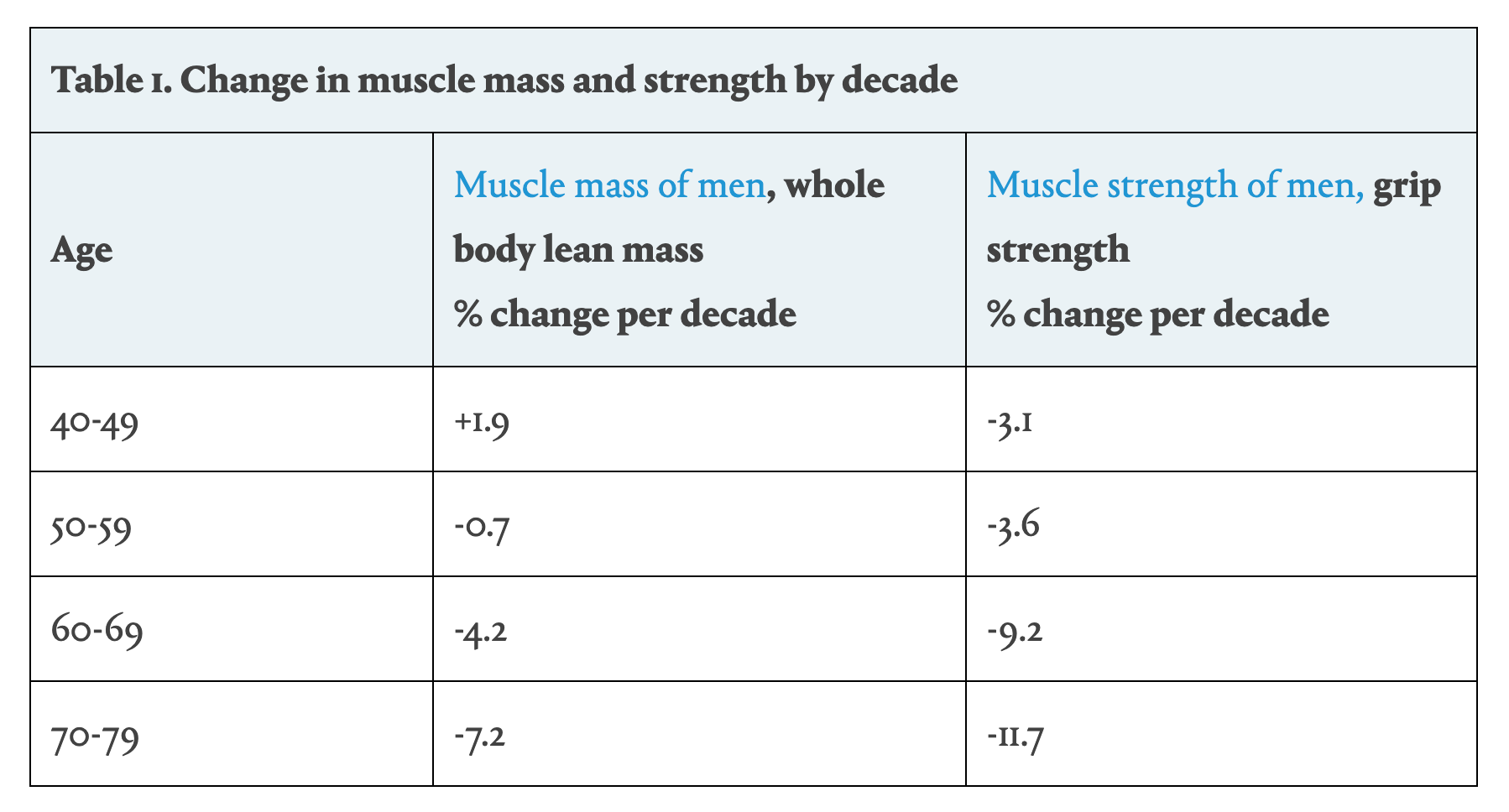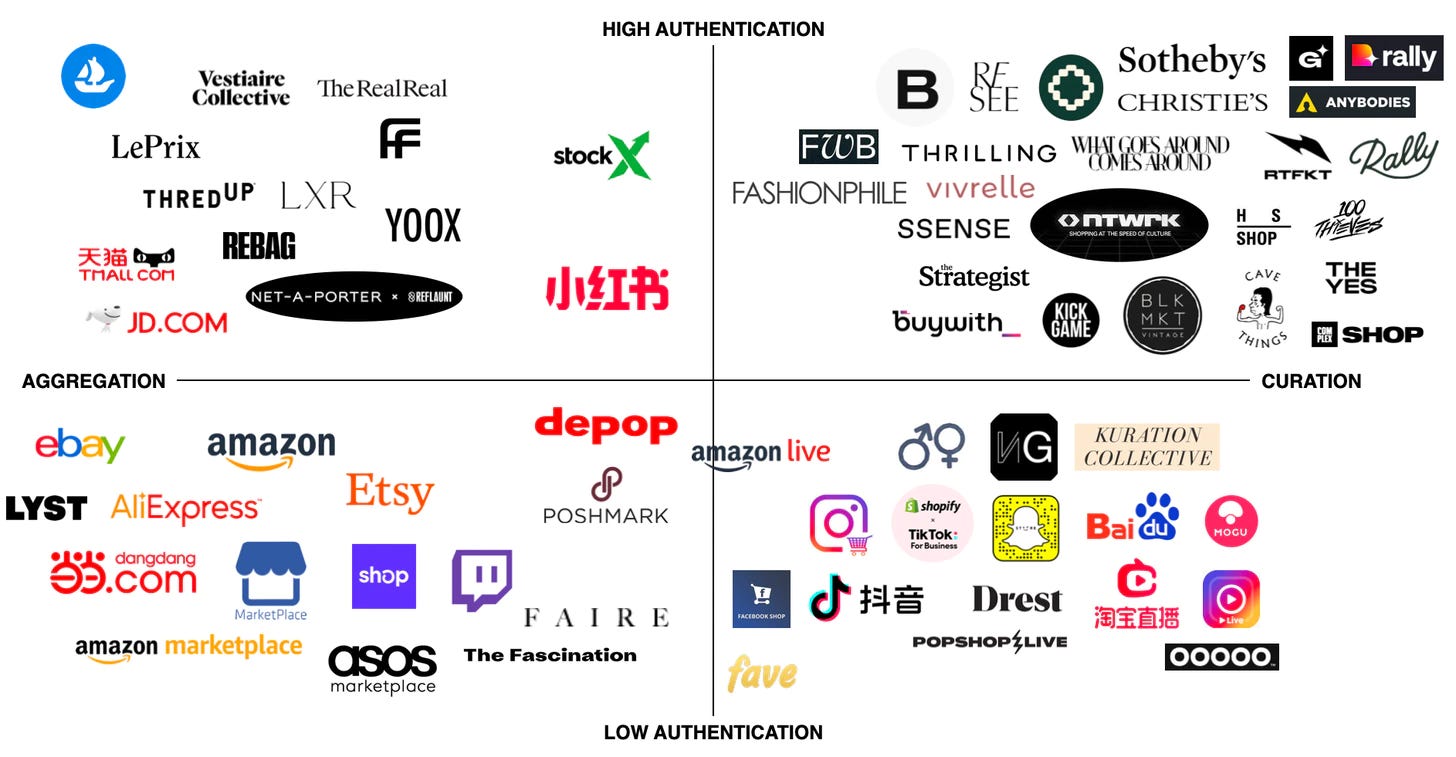Hi there, it’s Mehdi Yacoubi, co-founder at Vital, and this is The Long Game Newsletter. To receive it in your inbox each week, subscribe here:
💌 We’re inviting more and more people to Vital. If you want to be part of our early community, please, fill in this form! 💪
In this episode, we explore:
Let’s dive in!
🥑 Health
💪 Why do we Lose Muscle Strength with Age?
Peter Attia has a great write-up explaining why we lose muscle strength with age.
The table below shows the extent of the problem:
There are many reasons this is happening, among which:
Loss of Muscle Quality
“For instance, in older muscles, the excitation-contraction coupling becomes inefficient due to a decline in the number of calcium ion channels in the muscle fiber. Age is also associated with myosin structural changes that reduce its ability to remain in a strong-binding, force-generating state, so muscle contraction is weaker. Additionally, we accumulate oxidative stress-related DNA damage as we age, resulting in a decline in muscle mitochondrial function and lower mitochondrial density, ultimately leading to insufficient production of the ATP needed for muscle contraction.”
Loss of Innervation
“In addition to loss of muscle quality, another major factor contributing to muscle strength decline is the loss of neuromuscular innervation. Throughout one’s life, nerves constantly undergo cycles of innervating and denervating muscle fibers depending upon muscle usage. Muscles that experience high use through repetitive movements or greater tension have more nerve-muscle connections to support muscle activation. The more a muscle is used, the more neuromotor connections it develops, which leads to improved contractile strength. The opposite is also true: muscles that are seldom used become less innervated. Prolonged denervation leads to reduced function and deterioration of neuromuscular communication.”
So what can we do about this?
As you guessed, train your muscle to minimize these effects and stay strong and healthy while aging.
Now all of this information brings me to a simple conclusion – one which I’ve stated time and again: keep exercising throughout life. It is unequivocally the very best weapon in our arsenal when it comes to fending off a deterioration in health and extending lifespan. Improved neuromuscular communication is just one more example of the many mechanisms by which exercise counteracts or slows the physiological declines associated with the aging process. So perhaps I’m not saying anything you haven’t heard me say a thousand times before, but the message is so critical that it bears repeating over and over again. Maybe, on your 100th birthday, you’ll be glad I did.
For example, you can get started with pull-ups and push-ups.
Pair with: The importance of muscle mass, strength, and cardiorespiratory fitness for longevity
🌱 Wellness
😰 Time Anxiety
Have you ever had time anxiety? It’s the feeling that it’s “too late” to do something, write that book, ask that person, book that trip…
This is a great article to help you fight that familiar feeling.
While purpose in life is an important factor in the psychology of happiness, spending too much mental energy on finding it rather than doing things that make us happy can be anxiety-inducing. Here are three steps you can take to reduce time anxiety while still finding meaning in your day-to-day life:
Define what “time well spent” means to you: sit down, and think about what really makes you happy and gets you in the flow, without overthinking about how feasible the final outcome would be. Just think of your output and how it makes you feel to work on producing it. For example, don’t think about happy it would make you to publish a book. Ask yourself if you really enjoy writing. Don’t think about how proud you would be to run a marathon. Question whether you like running. Create a short list of activities you really enjoy and that bring value to yourself or to the world.
Make space for these moments: this does not mean making time for them. Instead, think of where you will incorporate these moments into your life. Maybe on your way to work. Maybe at home, after the kids are asleep. Or maybe spending time with your kids is the activity you want to make space for. If you happen to have less time than expected, that’s completely fine. It’s more about designing a space dedicated to your “time well spent” activities. As the prolific writer Maria Edgeworth said, “If we take care of the moments, the years will take care of themselves.”
Cut out time-consuming distractions: the moments we spend mindlessly scrolling on social media or watching random videos do contribute to time anxiety. Do a quick audit of your content consumption patterns and try to cut out the amount of time you spend in an input rather than output mode.
The most important one for me is to focus on balancing input vs. output. Consuming too much content (reading, watching, listening) is detrimental if not balanced by some time spent producing something (building, writing, podcasting, etc.)
Share
🧠 Better Thinking
❓ Be an Asker
Being persistent is one of the greatest life hacks. Ava puts it perfectly here.
To be clear, I don’t mean this in the sense of you should harass people. Asking in the wrong way can be bad, and asking when someone’s given you a firm no can be very very bad, so there’s some level of emotional sensitivity required here. But those are the exceptions, since most of the time you are not going to be penalized for asking. You penalize yourself: that’s why you don’t ask. But if you’re able to stop punishing yourself for asserting your needs, something very important changes. You become capable of advocating for yourself. Here are my general rules for asking:
If it’s very easy for the other person to say no (zero cost to them) and you’ll probably never see them again, ask whatever you want (politely)
If it’s something like asking someone to hang out, I think it’s okay to ask two times if the person is unresponsive/gives a neutral response. After that, cut your losses.
If you really, really want to press your case, I would say something like, “Letting you know that I really do want to meet up, and may follow up occasionally to see if you feel the same way. Is that okay?” Do not abuse this (for example, checking in once again after eight months is probably fine, and if they still seem uninterested just drop it).
Never get upset at someone for saying no. You don’t “deserve” an answer. The truth is, people who don’t know you don’t owe anything to you, and even people who know you really well are free to prioritize themselves (though you may want to rethink the relationship if they don’t seem to care about you, obviously).
How to become a good asker if you’re not?
I think the trickiest thing here (it’s been a multi-year journey for me, personally, so I get that it’s difficult) is sort of why PUA stuff exists and all these relationship manuals sell a bazillion copies—it’s really hard to fake security when you’re not secure, and asking just works a lot better if you’re coming from a secure place. However, I think that practicing asking can help you become more secure. So if you want to be more of an asker (this post is inspired by this Maybe Baby essay about ask culture vs guess culture, by the way), I would identify low-cost ways to ask and starting practicing those.
⚡️ Startup Stuff
🛣 Sticking with the Plan
In the current time of craziness in the markets, I remembered this excellent piece by Fred Wilson: Sticking With The Plan.
It doesn’t mean that you shouldn’t adapt to new constraints/contexts, but it’s essential to have a long-term strategy that will not change easily.
Managing a business is about having a plan, sticking with it, and not panicking or looking for hail mary passes. There are no silver bullets or shortcuts to success in life. You need to have a five to ten-year plan and you need to stick with it and execute against it day after day, week after week, year after year.
As we saw last week, “changing strategy feels like progress, but it usually isn’t.”
It’s fun to talk about strategy. It feels like you’re having a huge impact when some new insight changes everything. And changing strategy feels like an easy lever to pull when things aren’t moving fast enough or you’re bored. But, most of the time, it’s a chaotic waste of time for the team and delays real progress. Spend the extra time upfront to get the strategy right. Set the right metrics to understand whether you’re making progress. And then iterate on the tactics constantly.
Wilson concludes:
It is much more likely that you can get a win with a five-year plan than a one-year plan. And you need to build your team over time, developing promising talent, and making smart upgrades when they are required.
There are times when you need to throw in the towel on the plan, blow things up, and execute a turnaround. That usually comes with new leadership at the top and a new five-year plan. But that should be rare and done only when it is clear that the current plan is not working.
When the current plan is working, even better than expected, it is best to stick with it, make incremental improvements here and there, and keep at it.
Pair with: Keep it going
It’s astounding, isn’t it? Some of the best athletes in the world spend almost all their time working way below potential, purposefully not pushing themselves to the limits.
📚 What I Read
Duels can be brutal and even lethal. But duels emerged in societies around the world for an important reason: to control and manage violence, not just to celebrate it.
Violence is dramatic: fascinating, horrifying, alluring, upsetting. Individuals or groups come into conflict – interests opposed, incentives misaligned – and the use of physical force is one conceivable response. Because of the consequences it can have, societies have developed traditions to navigate and manage violence and how it is expressed. Cultural norms and institutions often work to constrain antisocial forms of violence within communities while promoting it against adversaries or in other contexts where it is more socially acceptable. Duelling traditions, from the use of wooden clubs to firearms, have historically been one method of managing conflicts between individuals. Duels tend to be regulated affairs, no mere heated displays of aggression. These are contests with established rules and standards of conduct, often discouraging lethality, and with an eye ultimately towards reconciliation and resolution rather than indefinite conflict or the permanent removal of an adversary.
Age is only just a number (when you keep the right mindset):
Among the things one learns as time passes is that everyone has to age, but not everyone has to get old. One of the best ways to stay young is to keep learning.
That’s one of the reasons I’ve spent the better part of the past two years trying my hand at developing a mobile app. To be more precise, I’ve been working with a team of developers to bring into the digital age a card game that dates back to at least the Second World War, and perhaps earlier. Starting this week, I’m pleased that it is now going to have a new life thanks to modern technology.
My involvement in this game — an incredibly devilish version of solitaire — starts with one of the greatest leaders of the 20th century at one of the most tumultuous times in world history. This is that story.
Authentication, visibility, and community are key:
Doubling down on the exploration of the new commerce opportunity landscape, I looked into the features that power the existing and emerging commerce destinations. This space is defined by two axes. The first axis goes from an aggregate of items to the curated selection of items. At the one end is Amazon with little guidance below product reviews and on the other are sites that provide an informed point of view, like The YES, 100 Thieves, NTWRK or The Strategist. The second axis goes from low to non-existent product authentication to high product authentication. At the top of this axis are goods authenticated on blockchain and digital goods, and on the bottom goods of the unknown or generic origin.
On how Square went from “users” to “customers.”
Team,
I was reminded of something today which has always bothered me, which I have since taken for granted.
The entire technology industry uses the word “user” to describe its customers. While it might be convenient, “users” is a rather passive and abstract word. No one wants to be thought of as a “user” (or “consumer” for that matter). I certainly don’t. And I wouldn’t consider my mom a “user” either, she’s my mom. The word “user” abstracts the actual individual. This may seem like a small and insignificant detail that doesn’t matter, but the vernacular and words we use here at Square set a very strong and subtle tone for everything we do. So let’s now part ways with our industry and rethink this.
The word “customer” is a much more active and bolder word. It’s honest and direct. It immediately suggests a relationship we must deliver on. And our customers think of their customers in the same way.
We have two types of customers: sellers and buyers. So when we need to be more specific, we’ll use one of those two words.
The other thing that has surfaced in a number of my 1:1s is that we have become a bit abstract and distanced from our customers. Simply: we don’t talk about them enough. So, we’re going to do two things.
First, I’m going to work with the support team to surface top issues at every Town Square instead of just CS inquiries per transaction percentages. And on our information radiators. We must feel our customer’s issues every day.
Second, all of our work is in service of our customers. Period. Therefore, we better damn well mention them in every conversation, review, meeting, goal, etc. I expect all of you to make certain our customers are always the first and only focus of all our efforts. If there is an egregious absence of this focus anywhere in the company, tell me and we will correct. If I ever say the word “user” again, immediately charge me $140.
An important result for parents:
Primal world beliefs (‘primals’) are beliefs about the world’s basic character, such as the world is dangerous.
This article investigates probabilistic assumptions about the value of negative primals (e.g., seeing the world as dangerous keeps me safe). We first show such assumptions are common. For example, among 185 parents, 53% preferred dangerous world beliefs for their children. We then searched for evidence consistent with these intuitions in 3 national samples and 3 local samples of undergraduates, immigrants (African and Korean), and professionals (car salespeople, lawyers, and cops;), examining correlations between primals and eight life outcomes within 48 occupations (total N=4,535).
As predicted, regardless of occupation, more negative primals were almost never associated with better outcomes. Instead, they predicted less success, less job and life satisfaction, worse health, dramatically less flourishing, more negative emotion, more depression, and increased suicide attempts.
We discuss why assumptions about the value of negative primals are nevertheless widespread and implications for future research.
🍭 Brain Food
📈 The Overblown Implications Effect
I came across this paper that I found fascinating. Here’s the abstract:
People frequently engage in behaviors that put their competencies on display. However, do such actors understand how others view them in light of these performances?
Eight studies support an overblown implications effect (OIE): Actors overestimate how much observers think an actor’s one-off success or failure offers clear insight about a relevant competency (Study 1). Furthermore, actors overblow performances’ implications even in prospect, before there are experienced successes or failures on which to ruminate (Studies 2 and 3).
To explain the OIE, we introduce the construct of working trait definitions—accessible beliefs about what specific skills define a general trait or competency. When actors try to adopt observers’ perspective, the narrow performance domain seems disproportionately important in defining the general trait (Study 4). By manipulating actors’ working trait definitions to include other (unobserved) trait-relevant behaviors, we eliminated the OIE (Study 5).
The final 3 studies (Studies 6a– 6c) more precisely localized the error. Although actors and observers agreed on what a single success or failure (e.g., the quality of a single batch of cookies) could reveal about actors’ narrow competence (e.g., skill at baking cookies), actors erred in thinking observers would feel this performance would reveal a considerable amount about the more general skill (e.g., cooking ability) and related specific competencies (e.g., skill at making omelets).
Discussion centers on how the present theoretical account differs from previous explanations why metaperceptions err and identifies important open questions for future research.
Here’s what it means:
As people navigate through their personal and professional lives, they aim not merely to passively estimate but also to actively manage others’ impressions. Thus, metaperceptions are important barometers of whether people (think they) are doing so effectively.
When people’s metaperceptions are inaccurate, they may make suboptimal decisions about how best to invest in further impression management. Those who make a single inane comment during a work meeting may go to unnecessary lengths to redeem themselves in the eyes of their colleagues, and those who offer a single stroke of genius may be mistaken about how much they can rest on these (thin) laurels.
We may do well to keep in mind that although our specific competencies are sometimes on full display, our broader abilities almost never are.
🎥 What I’m Watching
🧠 Your Attention Sucks
This is a video on attention-grabbing (particularly on YouTube) and how it harms what would we consider "high-quality content."

💊 The Philosophy of the Matrix
The Matrix, a science fiction film created by the Wachowskis, is probably one of the most influential movies ever made. The story starts when computer programmer Thomas Anderson, operating as a hacker under the alias “Neo,” discovers the truth about the world he’s living in, as he becomes aware of the existence of something known as “The Matrix.”
The Matrix is considered a philosophical film that contains many existing philosophical and religious themes, like prophecy, love, truth, karma, the nature of reality, and living in a sition. But there seems to be a particularly close connection between The Matrix and Plato’s Allegory of the Cave.
This video (All I’m Offering Is The Truth | The Philosophy of the Matrix) is a philosophical analysis of the Matrix film. It analyses The Matrix through the lens of Plato’s Allegory of the Cave while exploring the following question: do we, as human beings, actually want the truth?

🔧 The Tool of the Week
I’ve been playing a bit with BeReal lately. A very well-done product. The product's simplicity must have been the result of long months of experimentation. Congrats to them!
🪐 Quote I’m Pondering
Love is a decision, it is a judgment, it is a promise. If love were only a feeling, there would be no basis for the promise to love each other forever. A feeling comes and it may go. How can I judge that it will stay forever, when my act does not involve judgment and decision.
— Erich Fromm
If you enjoyed this newsletter, make sure to subscribe if you haven’t 👇
👋 EndNote
Thanks for reading!
If you like The Long Game, please share it on social media or forward this email to someone who might enjoy it. Podcast reviews are also gratefully received. You can also “like” this newsletter by clicking the ❤️ just below, which helps me get visibility on Substack.
Share
Feel free to email me or find me on Twitter if you have any feedback or questions.
Until next week,
Mehdi Yacoubi
PS: Lots of newsletters get stuck in Gmail’s Promotions tab. Please help train the algorithm by dragging it to Primary if you find it there. It makes a big difference.
Leave a comment







